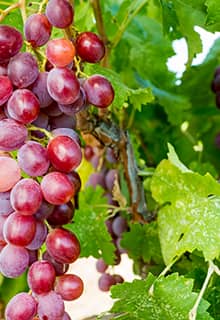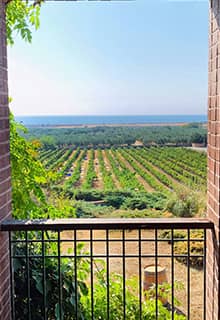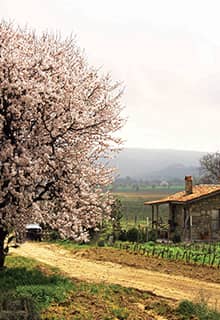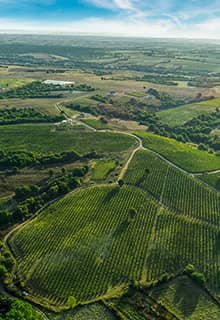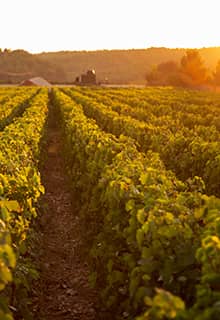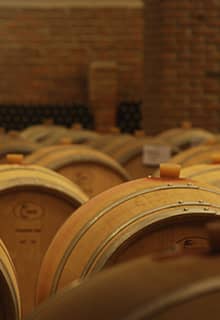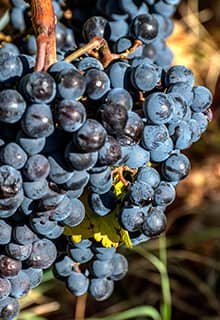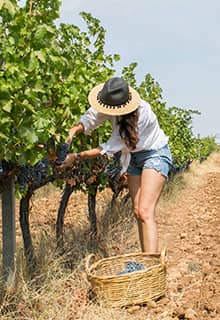

Thrace Vineyard Route
Wines of Ancient Times
With its ancient vineyard routes and magnificent vineyards, the Thrace Vineyard Route offers a great alternative for those who seek unforgettable natural and cultural experiences, and the exquisite flavors of local cuisine.
The history of viticulture in Thrace (Trakya in Turkish) dates back to ancient times. In his epic poem Iliad, Homer mentioned the honey-sweet black wine produced here. For thousands of years, generations of local farmers have taken advantage of this fertile soil, flat geography, and the perfect climate to grow the best grapes for wine production. The secret behind the Thrace Vineyard Route might be the land’s tectonic character. The early volcanic activity has ensured a rich and fertile soil, and the perfect conditions for grape cultivation.
The Thrace Vineyard Route brings together boutique wine producers located in four main areas: Kırklareli, Tekirdağ, Şarköy, and Gelibolu. The route passes through mountains, forests, and various microclimates surrounded by three seas: the Sea of Marmara, the Aegean Sea, and the Black Sea.
In Thrace, bud break usually takes place in April and typically harvest occurs in October. Since the Thrace Vineyard Route is very popular, it's better to book ahead for tours, vineyard restaurants, and on-site accommodation.
Throughout history, Kırklareli has been an important region in terms of viticulture. The historical vineyard routes, which traverse the inner parts of Thrace, intersect at Kırklareli. This route reaches the ports of İğneada and Midye (Kıyıköy) through the Istranca Mountains. Kırklareli forms an essential part of the Thrace Vineyard Route with its longoz (floodplain) forests, caves, ancient ruins, and beaches. It is culturally and historically rich, and abounds in natural beauty.
In the Kırklareli part of the route, the rustic vineyards are worth visiting to taste wines produced from indigenous and foreign grape varieties. Besides the local Papazkarası, Kalecik Karası, and Adakarası, there are foreign varieties grown here such as Cabernet Franc, Cabernet Sauvignon, Cinsault, Gamay, Merlot, Riesling, Sauvignon Blanc, Sémillion, Shiraz, and Viognier.
Kalecik Karası is used mainly in a wine that has a red-rose color, a sweet aroma, and is not tannin-dense.
Kırklareli is known for its tasty goat cheese and tandır (tandoori) meat dishes. The region is rich in terms of both history and nature. The İğneada Longoz Forests National Park, famous for its longoz (floodplain) forests, and the beautiful Dupnisa Cave deserve a visit. You can also add the villages of Kıyıköy and Vize to your travel itinerary.
Tekirdağ is one of the route’s central points and viticulture is an essential source of income in the villages within the provincial borders.
In the Tekirdağ area, the mature wines produced by local wineries are delicious and balanced, with distinctive flavors. The Cabernet Franc, Cabernet Sauvignon, Cinsault, Gamay, Kalecik Karası, Merlot, Papazkarası, Riesling, Sauvignon Blanc, Sémillion, Shiraz, and Viognier varieties are widespread here. While visiting Tekirdağ vineyards, do not forget to taste the mouthwatering local köfte (meatballs) and to stop by the Tekirdağ Museum of Archaeology and Ethnography, Rüstem Pasha Mosque, Namık Kemal House Museum, the ancient city of Perinthos, and the Rákóczi Museum.
Uçmakdere has made a name for itself on the Thrace Vineyard Route in recent years and has become famous for its paragliding school. It is located 35 kilometers from Tekirdağ and is perfect for hiking and photography expeditions in nature. Uçmakdere is one of the last surviving examples of modest village life with its wooden houses and the river that runs through it. The village hosts an international paragliding festival every year. One last tip: do not leave Uçmakdere without having a typical village breakfast.
With its 60-kilometer-long beach, Şarköy is another remarkable stop. During your visit here, you can enjoy the sea together with the sunshine and taste delicious olives and fresh fish. Şarköy vineyards have unique soil and the slopes running perpendicular to the sea make the best of the night and day temperature difference, giving the wine a rich aroma. The history of viticulture here dates back to ancient times: some of the amphora-laden shipwrecks found in Yenikapı (Yenikapı Wreck 11) are thought to have set off from this region.
Mürefte is another beautiful coastal town and the production center of many wine brands. The city, whose settlement dates to ancient times, is 13 kilometers from Şarköy and the vineyards on its hills produce delicious wines. Mürefte is a popular stop for its beaches, historic houses, and fish. It attracts the attention of visitors with the wine museums that can be found within the wineries. Feyzi Kutman Wine Museum and Aker Wine Museum, which, among others, display photographs, paintings, ancient wine production accessories, Roman amphoras, bottles, and scales, are worth visiting. You can also purchase small batch premium olive oil, vinegar, and grape seed natural soap to take back as souvenirs and gifts.
The last part of the Thrace Vineyard Route is the historical Gelibolu Peninsula. Blending history, mythology, and viticulture, Gelibolu is a perfect location for wine lovers. The local vineyards produce wonderful wines made from the indigenous Karasakız and Kınalı Yapıncak, and the foreign varieties Cabernet Franc, Cabernet Sauvignon, Chardonnay, Merlot, Sauvignon Blanc, Shiraz, and Grenache. Gelibolu is the land where the legendary Gallipoli Campaign took place during World War I. Anzac Day, observed on April 25, is a remembrance day originally dedicated to the members of the Australian and New Zealand Army Corps (ANZAC) who served in the Gallipoli Campaign. Today, the commemoration has expanded to include all Australians and New Zealanders who have served in wars. In Türkiye, on Anzac Day, the relatives of soldiers from both sides pay their respects to the those who sacrificed their lives in the Gallipoli Campaign.
Scuba diving enthusiasts will definitely fall in love with Saros Bay, which Jacques Cousteau visited. At ancient Troy (Troia in Turkish), located on the Asian side of the Çanakkale Strait history, blends with literature and mythology.

